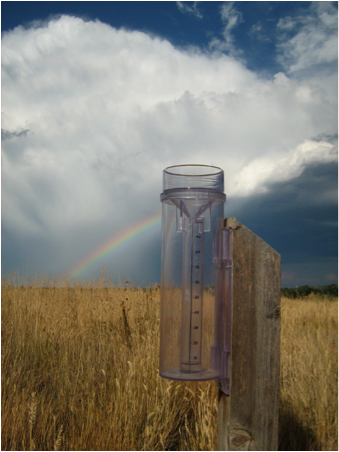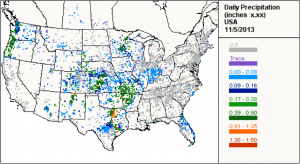
A CoCoRaHS-certified rain gauge. Photo: CoCoRaHS.
It may have a long name, but the Community Collaborative Rain, Hail and Snow Network makes quick and easy work of measuring precipitation.
Rain and snow fall have long been difficult to monitor. But that’s less of a problem thanks to a simple rain gauge and citizen participation, said Jeff Andresen, Michigan’s state climatologist and coordinator of the state chapter of the national group known as CoCoRaHS.
Anyone can join. The only requirements are a rain gauge and an enthusiasm for the environment, Andresen said.
The gauge is a 14-inch tall by four and a quarter-inch wide cylinder containing a measuring tube that holds up to an inch of fallen water. The measurements go by increments of one hundredth of an inch. It is easy to read and observers record their data online, preferably every morning, Andresen said.
The information goes into a database and is used by many organizations, including the National Weather Service, which uses it to monitor precipitation where its radar doesn’t reach. The weather service also uses the snow measurements recorded by CoCoRaHS to predict how much water will be added to rivers when the snow melts, said Noah Newman, education director for CoCoRaHS. That helps predict floods.
CoCoRaHS started in 1998 in Colorado as a response to thunderstorms in 1997 that caused devastating floods and multiple deaths, Andresen said.
The program has more than 18,000 observers from all 50 states and the District of Columbia. There are also more than 370 Canadian observers since CoCoRaHS went international in 2011, said Zach Schwalbe, national coordinator for CoCoRaHS.
Each day, roughly 10,000 members report measurements, Newman said.
The program gives people the sense of direct involvement with monitoring the environment.
“It’s a chance for people to actually get their hands dirty,” Andresen said. “It’s a way to get physically involved.”
CoCoRaHS is an example of an “ultimate grassroots volunteer community effort to monitor precip,” Andresen said. It is funded by many organizations, including the National Oceanic and Atmospheric Administration and the National Science Foundation, but most support comes from donations.
A big reason this community is vital to weather forecasting is a lack of observational sites for precipitation, Andresen said. In the case of the 1997 Colorado floods, the thunderstorms, which were only a few miles wide, occurred between observation sites, Andresen said. The National Weather Service was unaware the system was dumping this much rain and was unable to issue the proper flood warnings.
The idea for a community-driven precipitation network was put together by Nolan Doesken, state climatologist for Colorado. He knew it would greatly expand the area of observations in a way that wouldn’t cost anyone a lot of money and allow citizens direct involvement in a critical matter, Andresen said.
It feels good to be part of something important, said Jason Floyd, a Vermont resident and a member of CoCoRaHS since April 2007.

Each dot represents an observation point from November 5, 2013. Photo: CoCoRaHS.
“If we don’t do the measurements at our house, they wouldn’t get done,” Floyd said. “The records we create wouldn’t be out there.”
Observers like Floyd pay $25 for the rain gauge and take a training session to become part of CoCoRaHS, Andresen said. Training may be done online or in person. Both methods take around three hours to complete. Beyond that, it is relatively hassle free. Taking measurements of rain is very simple and only takes a minute to record and enter online, Andresen said.
The only thing that is a bit of a hassle is measuring snow, where the observer must melt it to determine how much water was in the snow. The amount of snow per inch of water can range anywhere from six inches for the wettest snow to 25 or more inches for drier, lake-effect type snow, Andresen said.
To join CoCoRaHS, click here.